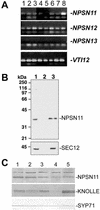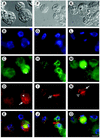NPSN11 is a cell plate-associated SNARE protein that interacts with the syntaxin KNOLLE
- PMID: 12068098
- PMCID: PMC161670
- DOI: 10.1104/pp.003970
NPSN11 is a cell plate-associated SNARE protein that interacts with the syntaxin KNOLLE
Abstract
SNAREs are important components of the vesicle trafficking machinery in eukaryotic cells. In plants, SNAREs have been found to play a variety of roles in the development and physiology of the whole organism. Here, we describe the identification and characterization of a novel plant-specific SNARE, NPSN11, a member of a closely related small gene family in Arabidopsis. NSPN11 is highly expressed in actively dividing cells. In a subcellular fractionation experiment, NSPN11 cofractionates with the cytokinesis-specific syntaxin, KNOLLE, which is required for the formation of the cell plate. By immunofluorescence microscopy, NSPN11 was localized to the cell plate in dividing cells. Consistent with the localization studies, NSPN11 was found to interact with KNOLLE. Our results suggest that NPSN11 is another component of the membrane trafficking and fusion machinery involved in cell plate formation.
Figures






Similar articles
-
Syntaxin specificity of cytokinesis in Arabidopsis.Nat Cell Biol. 2003 Jun;5(6):531-4. doi: 10.1038/ncb991. Nat Cell Biol. 2003. PMID: 12738961
-
Conversion of functional specificity in Qb-SNARE VTI1 homologues of Arabidopsis.Curr Biol. 2005 Mar 29;15(6):555-60. doi: 10.1016/j.cub.2005.02.021. Curr Biol. 2005. PMID: 15797025
-
Functional anatomy of the Arabidopsis cytokinesis-specific syntaxin KNOLLE.Plant J. 2011 Dec;68(5):755-64. doi: 10.1111/j.1365-313X.2011.04736.x. Epub 2011 Sep 19. Plant J. 2011. PMID: 21838778
-
Membrane trafficking in plants: new discoveries and approaches.Curr Opin Plant Biol. 2004 Dec;7(6):701-7. doi: 10.1016/j.pbi.2004.09.016. Curr Opin Plant Biol. 2004. PMID: 15491919 Review.
-
Plant cytokinesis: KNOLLE joins the club.Curr Biol. 2001 Jun 5;11(11):R423-6. doi: 10.1016/s0960-9822(01)00251-2. Curr Biol. 2001. PMID: 11516663 Review.
Cited by
-
Regulation of membrane trafficking and organ separation by the NEVERSHED ARF-GAP protein.Development. 2009 Jun;136(11):1909-18. doi: 10.1242/dev.033605. Development. 2009. PMID: 19429787 Free PMC article.
-
Evolution of the endomembrane systems of trypanosomatids - conservation and specialisation.J Cell Sci. 2017 Apr 15;130(8):1421-1434. doi: 10.1242/jcs.197640. Epub 2017 Apr 6. J Cell Sci. 2017. PMID: 28386020 Free PMC article.
-
Plasma membrane protein trafficking in plant-microbe interactions: a plant cell point of view.Front Plant Sci. 2014 Dec 22;5:735. doi: 10.3389/fpls.2014.00735. eCollection 2014. Front Plant Sci. 2014. PMID: 25566303 Free PMC article.
-
Cell wall pectins and xyloglucans are internalized into dividing root cells and accumulate within cell plates during cytokinesis.Protoplasma. 2005 Oct;225(3-4):141-55. doi: 10.1007/s00709-005-0095-5. Epub 2005 Oct 5. Protoplasma. 2005. PMID: 16228896
-
Cloning and characterization of three genes encoding Qb-SNARE proteins in rice.Mol Genet Genomics. 2008 Mar;279(3):291-301. doi: 10.1007/s00438-007-0313-2. Epub 2008 Jan 16. Mol Genet Genomics. 2008. PMID: 18197419
References
Publication types
MeSH terms
Substances
Associated data
- Actions
LinkOut - more resources
Full Text Sources
Molecular Biology Databases

